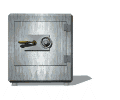|
Today about 20 billion coins a year are made at the U.S. Mint in Denver and Philadelphia. All coins are marked with a letter designating where they were made.
If you have a quarter handy, look at the tiny letter next to George Washington’s ponytail. If the quarter is new, you will see a P or D, which means the coin was made in Philadelphia or Denver. If it’s an old coin, you may see an O or S, meaning New Orleans or San Francisco, cities where coins used to be made.
 Our government no longer uses silver or gold in coins but nickel and copper alloys. These metals are melted and poured into ingots or bars. Then machines roll the ingots into sheets. Our government no longer uses silver or gold in coins but nickel and copper alloys. These metals are melted and poured into ingots or bars. Then machines roll the ingots into sheets.
All coins start as blanks (round disks), which are punched out of these metal sheets. The blanks are then heated, washed and dried. Blanks roll through something called an upsetting mill which raises a rim around the edge of each blank. Next comes adding the design and lettering, called "striking." Once "struck", inspectors check to make sure the coins are ready to be counted, bagged and ready for circulation.
Coins remain in circulation for about 30 years before they need to be replaced due to wear. Compare that to some bills that last less than 2 years!
 In 1979, the mints began to make Susan B. Anthony dollar coins, but few people liked to use them so our government was stuck with a surplus supply. Fortunately, by 2000, the government's extra supply of Susan B. Anthony's had dwindled. In 1979, the mints began to make Susan B. Anthony dollar coins, but few people liked to use them so our government was stuck with a surplus supply. Fortunately, by 2000, the government's extra supply of Susan B. Anthony's had dwindled.
|
In January 2000, the government replaced the Susan B. Anthony dollar coin with the Golden Dollar coin, as required by the U.S. $1 Coin Act of 1997.
 The dollar coin bears the image of Sacagawea, the Shoshone woman who served as a guide for the Lewis and Clark expedition in 1804-1806. In 2002, the government decided to halt production temporarily when supply of these coins exceeded the demand anticipated for the next four years. The dollar coin bears the image of Sacagawea, the Shoshone woman who served as a guide for the Lewis and Clark expedition in 1804-1806. In 2002, the government decided to halt production temporarily when supply of these coins exceeded the demand anticipated for the next four years.
You can feel ridges on the edges of dimes, quarters, half-dollars and Susan B. dollars. The ridges were put there to solve an old problem. When coins were made of precious metals, like gold and silver, people used to shave the edges and sell the shavings. So the U.S. Treasury added ridges, called “reeded” edges.
 All coins have two phrases on them. The first is "E Pluribus Unum" which is Latin for "one out of many." It is our motto and means "one country out of many states." All coins have two phrases on them. The first is "E Pluribus Unum" which is Latin for "one out of many." It is our motto and means "one country out of many states."
The other phrase is "In God We Trust." This motto was placed on U.S. coins mainly because of the increased religious sentiment that existed during the Civil War.
 Anyone who has his or her picture on a coin or bill must be dead. This is because English kings used to put their pictures on coins as a sign of power. Americans didn’t like that idea so we passed a law in 1866 that only dead people can appear on U.S. money. Anyone who has his or her picture on a coin or bill must be dead. This is because English kings used to put their pictures on coins as a sign of power. Americans didn’t like that idea so we passed a law in 1866 that only dead people can appear on U.S. money.
|